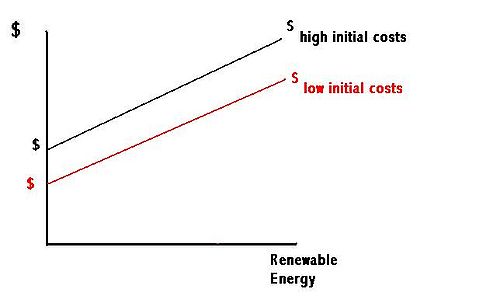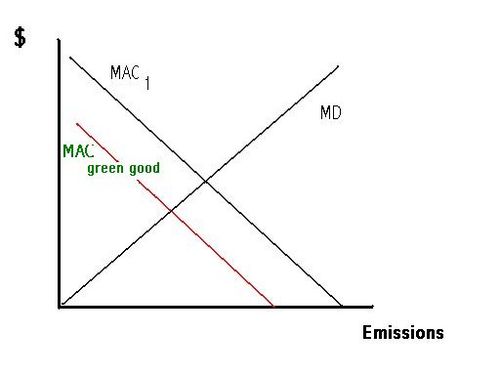Course:ECON371/UBCO2010WT1/GROUP8/Article6
Sacramento wants solar farm at site of former landfill
Summary
Sacramento's city council has approved an interesting project involving the establishment of a solar farm on a former landfill. An exclusive lease would be granted to a German company, Conenergy Projects Inc. Along with other revitalization projects slated for development on the site, including dog parks, nature trails, and a skate park, the solar farm would be part of a long-term plan for the currently unoccupied property. The project would provide revenues for the city as well as a viable source of green energy.
The project is expected to provide enough power to supply 16,000 homes, but development would be incremental. Demand for renewable energy is still affected by the high costs of its provision. Although state law requires utility companies to procure 20% of their energy from renewable resources, companies that already meet those targets have no incentive to purchase more. Therefore, the demand for the energy that this farm produces may not be sufficient to cover its costs, as Conenergy has yet to reach an agreement with one of three local utility companies.
Dedicated to this initiative, city officials are planning to help Conenergy get funding from the federal government, as well as developing financial plans that may involve revenue-sharing and other alternative lease payments.
Analysis
The downside to most renewable energy projects is that they often require a significant allocation of undeveloped and unused land. If we were to measure the ratio of production of kilowatt-hours per square foot for a typical coal or nuclear power plant versus those for the typical - or hypothetical - solar or wind farm, it would be clear that the renewable energy sector places a higher strain on land use. In a world where development encroaches further and further into previously undeveloped areas, coupled with the fact that these developments already encounter much social resistance, it is difficult to imagine that the acquisition of land - even for renewable energy generation - will be easy.
As explored in the second Wiki project of this section, which discussed an article that reported United States Department of the Interior's decision to dedicate public land to renewable energy projects, the issue of procuring land is a major obstacle in the way of realizing such projects. This was a ground-breaking decision by the government, as it remains prohibitively expensive for private firms to purchase of large tracts of land needed to establish economically viable renewable energy production facilities. The purchase of land, and its accompanying abatement costs to alleviate the environmental impact on its surroundings, make up a huge portion of the necessary initial investment to get these projects off the ground. Many more projects could become feasible as a result of eliminating, or significantly reducing, these initial investments. Returns would be speedier and risk would be reduced, making these projects more attractive to potential investors.
However, the use of public land for the purposes of extracting renewable energy is not an ideal solution. This land has been protected for many reasons, and to promote development upon it seems counter-productive. Additionally, public land itself is a finite resource that many people feel needs to be conserved. What was not mentioned in the article is that there are other properties that may be considered before moving into undeveloped portions. The city of Sacramento's plan to develop a solar farm on the site of a former landfill introduces us to a world of possibilities for repurposing land that has declined in value or is otherwise difficult to re-use. There are many examples of properties that have been used for industrial purposes and now remain vacant as a result of extremely high clean-up costs involved in returning the land to a state where successive development can occur. Landfills and other polluted or otherwise unattractive lands could instead be used for purposes that do not rely on the aesthetics of the surrounding environment. Toxic sites, such as the tar ponds of Sydney, Nova Scotia, would require immense investment before any reclamation of this land can occur. Abandoned open-pit mines are a blemish on the landscape, and development of any other industry upon this land seems very unlikely. Since these are virtually unusable by other industries, their cost to acquire would most certainly be relatively minimal. There are many more examples of such sites that may not necessarily be ideal locations for the renewable sector, but would alleviate much of the initial costs of land procurement. It would also reduce economic inefficiencies and losses to governments that do not collect taxes as a result of the non-use of the land. The additional benefits of providing a "green source of energy", essentially describing the provision of a type of green good, which lowers aggregate abatement costs for the region. Furthermore, abatement costs related to clean-up and revitalization of these lands would undoubtedly be reduced.
The city of Sacramento's long-term plan for the landfill includes the construction of trails, dog parks, and a skate park along with the proposed solar farm. These other amenities are valuable to society in their own right, and as explained in the article, the demand for solar energy from the utility companies is limited. State law requires utility companies to procure a minimum of 20% of their energy from renewable resources. This could be considered a performance standard, where the utilities companies are free to choose how to achieve this goal. The compliance costs associated with this law would be considered as marginal abatement costs of each company. Since renewable energy procurement still incurs high costs, utility companies have no incentive to purchase any more than the required 20%. This is the reason why the solar farm would only be built in small increments, and expand only if demand increases. It is reasonably foreseeable that demand must eventually increase, whether through more stringent government policies or other developmental factors. Thus, would the investment of resources into the development of trails and parks be a sensible decision for the long-term if the land could be needed for expansion of the solar farm?
Surprisingly, there was no mention of the option to sell the power to neighbouring municipalities who face the same law of acquiring 20% of their energy from renewable resources. Sacramento is situated in a densely populated area in the most populous state in the country. There is reason to believe that there exists many proximal communities that could benefit from the energy surpluses of the solar farm, and that their delivery would not be burdened by excessive costs; at least, not so much as to negate the benefits of avoiding the establishment of their own renewable energy projects. The benefit of this undertaking could reduce the constraint faced by other municipalities in developing their own local renewable energy programs. Surely, there must be inefficiencies involved with establishing multiple smaller renewable energy projects - which may use potentially more expensive or desirable land - as opposed to using the excess power supplied by a single producer on cheap land. For any level of demand, acquiring energy from the producer with lower initial costs must be more efficient. Considering stakeholders outside the immediate boundaries of the city of Sacramento, instead of beautifying these lands with intensive landscaping and transformation - of which no revenue is gained after the fact - greater social benefits could come from the economies of scale of establishing a larger solar farm and selling the excess to neighbouring municipalities. Although this may prove false, it is definitely worth considering.
Prof's Comments
I like your reflection on the use of this low value land, and identifying other potential sites. Have read an article in the past about covering parking lots with solar farms. Same idea.

